RDA: Resource description and access part 1 - Joint Steering ...
RDA: Resource description and access part 1 - Joint Steering ...
RDA: Resource description and access part 1 - Joint Steering ...
- No tags were found...
You also want an ePaper? Increase the reach of your titles
YUMPU automatically turns print PDFs into web optimized ePapers that Google loves.
5JSC/<strong>RDA</strong>/Part I/CILIP response5JSC/<strong>RDA</strong>/Part I/Chapter 3/CILIP response20 March 2005p. 72.5.1.4: CILIP suggests that the text of this rule is, in fact, <strong>part</strong> of the definition of whatconstitutes an “edition” <strong>and</strong> should be included as <strong>part</strong> of 2.5.1.1. If that suggestion provesunacceptable to JSC, CILIP recommends that the identification of what constitutes an “edition”should precede any instruction on how to record one. It seems illogical to be told how to recordan edition statement before one has determined that is indeed what one is dealing with.2.5.1.4: If <strong>RDA</strong> is going to have a useful rule for digital resources at 2.5.1.4 CILIP believes itneeds to take account of ISBD(ER) in this area. The word “version” or whatever may notindicate an edition change at all. This rule surely relates closely to rule 1.3 (Changes requiring anew <strong>description</strong>). Essentially, if 1.3 doesn’t tackle this problem of whether to create a new recordbecause of the presence of a potentially misleading term like “new version” <strong>and</strong> 2.5.1.4 bunglesit, then where is it going to be tackled? As far as e-resources go, rules 1.3 <strong>and</strong> 2.5.1.4 seem to beof limited help.2.5.2.3, final para.: This is expressed rather oddly <strong>and</strong> might confuse the reader. Suggestedrewording… record all statements of responsibility in the Title <strong>and</strong> statement of responsibility area2.6.5: Might it be clearer to read <strong>and</strong> underst<strong>and</strong> if this rule were split into 2.6.5.1 <strong>and</strong> 2.6.5.2,dealing with numbering <strong>and</strong> chronology separately? Or perhaps it’s simply that the ExamplesGroup needs to find a less confusing way of presenting the examples that illustrate the rule (inwhich case it’s a presentation issue only).2.7.0.5: Examples are given of imprints which name printer <strong>and</strong> publisher in a single statement(e.g. "Printed for the CLA by the Morriss Print. Co."). However, it would be helpful either hereor at 2.7.0.3 to have guidance for what to do in cases where two bodies are named but theseparate functions are less explicit, e.g. "Oxford University Press for the Bibliographic Society".One solution would be to generalise the option at the end of this rule by removing the need formultiple names to relate to different functionsOptionally, if the names of publishers, distributors, etc., appear on the sourceof information in the form of a single statement, record the statement as it appears.2.7.1.3: The provision of [Publisher unknown] (along with the equivalent provision for places <strong>and</strong>dates at 2.8.1.3 <strong>and</strong> 2.9.1.3) was another source of significant debate within CILIP. On one sidewere those who saw no problem – either for themselves or users of <strong>RDA</strong> data – in the continueduse of AACR2’s Latin abbreviations. On the other were those who recognised that theseabbreviations are little known outside specialist communities. Semantic difficulties, some of themso slight as to be virtually devoid of measurable substance, were found with all of the alternativetexts proposed. Readers of the <strong>RDA</strong>-L postings on this topic will have some sense of the issuesdiscussed. CILIP feels that the use of “unknown” in this context is not correct <strong>and</strong> would preferthe rule to require either Publisher not stated or Publisher not given.2.8.0.3: CILIP suggests adding a sentence making clear that prepositions associated with theplace of publication should be included in the transcription of that place, This is, generally, inorder to preserve grammatical integrity; also, in the case of early printed books, because inclusionof such prepositions is st<strong>and</strong>ard practice <strong>and</strong> contributes to identification.


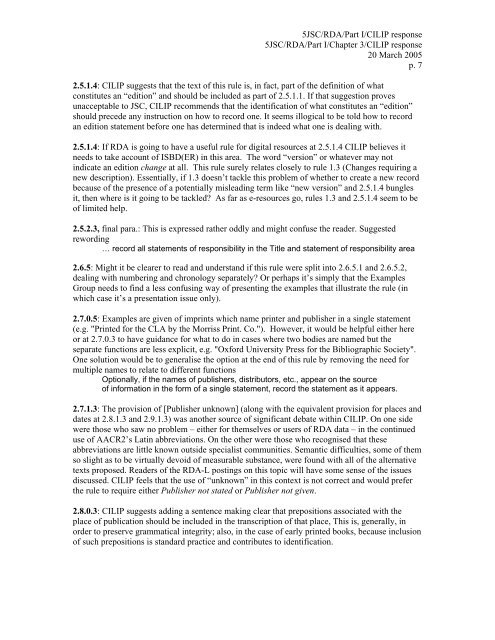

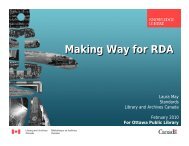
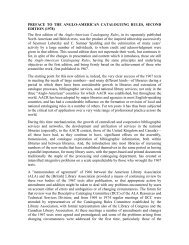
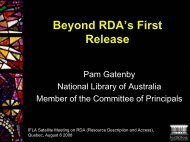



![Presentation slides [PDF] - Joint Steering Committee for ...](https://img.yumpu.com/41621230/1/190x143/presentation-slides-pdf-joint-steering-committee-for-.jpg?quality=85)

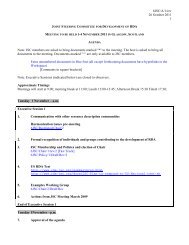
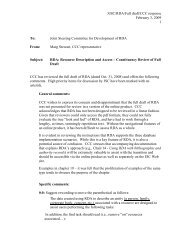
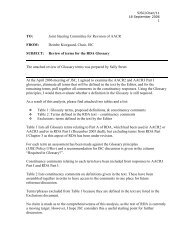
![Presentation slides [PDF] - Joint Steering Committee for ...](https://img.yumpu.com/35256207/1/190x143/presentation-slides-pdf-joint-steering-committee-for-.jpg?quality=85)
